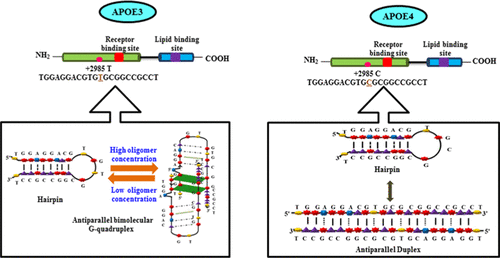Our official English website, www.x-mol.net, welcomes your feedback! (Note: you will need to create a separate account there.)
Structural Switch from Hairpin to Duplex/Antiparallel G-Quadruplex at Single-Nucleotide Polymorphism (SNP) Site of Human Apolipoprotein E (APOE) Gene Coding Region
ACS Omega ( IF 4.1 ) Pub Date : 2018-03-15 00:00:00 , DOI: 10.1021/acsomega.7b01654 Swati Chaudhary , Mahima Kaushik , Saami Ahmed , Ritushree Kukreti 1 , Shrikant Kukreti
ACS Omega ( IF 4.1 ) Pub Date : 2018-03-15 00:00:00 , DOI: 10.1021/acsomega.7b01654 Swati Chaudhary , Mahima Kaushik , Saami Ahmed , Ritushree Kukreti 1 , Shrikant Kukreti
Affiliation

|
A gradual dementia, which leads to the loss of memory and intellectual abilities, is the main characteristics of Alzheimer’s disease. Amyloid-β (Aβ) plaques are the main components that accumulate and form clumps in the brains of people suffering from Alzheimer’s disease. Apolipoprotein E (APOE), an amyloid-binding protein is considered as one of the main genetic risk factor of the late-onset Alzheimer’s disease. Different isoforms of APOE gene named APOE2, APOE3, and APOE4 are known to exist, which differ from each other at certain positions involving single-nucleotide polymorphisms (SNPs). Out of these isoforms, APOE4 increases the risk of developing late-onset Alzheimer’s disease, whereas APOE3 is the most common among the general population. APOE4 differs from the common APOE3 by only one nucleotide at position +2985 (T to C), which results in immense alteration in the structure and function of the APOE gene. A combination of gel electrophoresis (polyacrylamide gel electrophoresis, PAGE), circular dichroism (CD), CD melting, thermal difference spectra and UV-thermal denaturation (TM) techniques was used to investigate the structural polymorphism associated with T → C single-nucleotide polymorphism (SNP) at the GC-rich sequence (d-TGGAGGACGTGTGCGGCCGCCT; APOE22T). Herein, we report that APOE22T DNA sequence switches between hairpin to antiparallel quadruplex from low to high oligomer concentration. On the contrary, its C-counterpart (APOE22C) forms hairpin as well as intermolecular antiparallel duplex structure. This structural change may possibly contribute to the protein recognition pattern, which, in turn, might control the APOE gene expression.
中文翻译:

人类载脂蛋白E(APOE)基因编码区的单核苷酸多态性(SNP)位点从发夹结构转换为双链体/反平行G-四链体
导致痴呆的渐进性痴呆症是阿尔茨海默氏病的主要特征。淀粉样蛋白-β(Aβ)斑块是在阿尔茨海默氏病患者的大脑中积聚并形成团块的主要成分。载脂蛋白E(APOE)是一种淀粉样蛋白结合蛋白,被认为是晚期阿尔茨海默氏病的主要遗传危险因素之一。APOE的不同同工型已知存在名为APOE2,APOE3和APOE4的基因,它们在涉及单核苷酸多态性(SNP)的某些位置彼此不同。在这些亚型中,APOE4增加了罹患迟发性阿尔茨海默氏病的风险,而APOE3是普通人群中最常见的疾病。APOE4与普通APOE3的区别仅在于+2985位置(T到C)的一个核苷酸,这导致APOE基因的结构和功能发生巨大变化。凝胶电泳(聚丙烯酰胺凝胶电泳,PAGE),圆二色性(CD),CD熔化,热差光谱和UV-热变性的组合(Ť中号)技术用于研究与富含GC的序列(d-TGGAGGACGTG T GCGGCCGCCT; APOE22T)的T→C单核苷酸多态性(SNP)相关的结构多态性。在本文中,我们报道了APOE22T DNA序列在发夹之间转换,从低到高的低聚物浓度反平行四链体。相反,它的C-配体(APOE22C)形成发夹以及分子间反平行双链体结构。这种结构变化可能有助于蛋白质识别模式,进而控制APOE基因的表达。
更新日期:2018-03-15
中文翻译:

人类载脂蛋白E(APOE)基因编码区的单核苷酸多态性(SNP)位点从发夹结构转换为双链体/反平行G-四链体
导致痴呆的渐进性痴呆症是阿尔茨海默氏病的主要特征。淀粉样蛋白-β(Aβ)斑块是在阿尔茨海默氏病患者的大脑中积聚并形成团块的主要成分。载脂蛋白E(APOE)是一种淀粉样蛋白结合蛋白,被认为是晚期阿尔茨海默氏病的主要遗传危险因素之一。APOE的不同同工型已知存在名为APOE2,APOE3和APOE4的基因,它们在涉及单核苷酸多态性(SNP)的某些位置彼此不同。在这些亚型中,APOE4增加了罹患迟发性阿尔茨海默氏病的风险,而APOE3是普通人群中最常见的疾病。APOE4与普通APOE3的区别仅在于+2985位置(T到C)的一个核苷酸,这导致APOE基因的结构和功能发生巨大变化。凝胶电泳(聚丙烯酰胺凝胶电泳,PAGE),圆二色性(CD),CD熔化,热差光谱和UV-热变性的组合(Ť中号)技术用于研究与富含GC的序列(d-TGGAGGACGTG T GCGGCCGCCT; APOE22T)的T→C单核苷酸多态性(SNP)相关的结构多态性。在本文中,我们报道了APOE22T DNA序列在发夹之间转换,从低到高的低聚物浓度反平行四链体。相反,它的C-配体(APOE22C)形成发夹以及分子间反平行双链体结构。这种结构变化可能有助于蛋白质识别模式,进而控制APOE基因的表达。


























 京公网安备 11010802027423号
京公网安备 11010802027423号